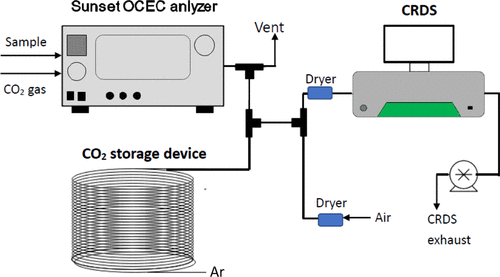Development of a Monitoring System for Semicontinuous Measurements of Stable Carbon Isotope Ratios in Atmospheric Carbonaceous Aerosols: Optimized Methods and Application to Field Measurements
ACS Publications:
Carbon content constitutes a major fraction of atmospheric particulate matter (PM) and directly influences the earth’s climate and human health. The stable carbon isotope ratios (δ13C) can be used to track potential sources and atmospheric processes of carbonaceous aerosols. Previously, determination of δ13C was always conducted in offline carbonaceous aerosol samples. The poor time-resolution results cannot provide information regarding the temporal evolution of δ13C at a short-time scale. In this study, we developed a new system for online measurements of δ13C in atmospheric carbonaceous aerosols by combining a semicontinuous organic carbon/elemental carbon (OC/EC) analyzer and online cavity ring-down spectroscopy (CRDS) (OC/EC analyzer-CRDS). To provide better stability in the determination of δ13C, a carrier gas with CO2 (∼200 ppm) in “balance gas” was used, and Keeling analysis was employed to separate the δ13C signal of the sample from background CO2 gas. Our results showed that the accuracy and absolute precision of the δ13C measurements by the OC/EC analyzer-CRDS system were better than 0.1‰ and 0.5‰, respectively, for the samples containing carbon content more than 5 μg. Furthermore, we employed this system to monitor δ13C (δ13C-TC) in particulate total carbon (TC) with a time resolution of 2–4 h over Beijing in late summer and early autumn, 2019. During the sampling period, the TC concentrations varied from 0.1 to 12.0 μg m–3 with a mean value of 6.0 ± 2.4 μg m–3. The δ13C-TC ranged from −28.2 to −24.2‰ (mean value was −25.9 ± 0.9‰) without significant diurnal variations, suggesting similar contributing sources to TC. Comparing the δ13C signatures of different emissions, we found that liquid fuels and primary and secondary C3 plants were likely the dominant sources of particulate TC. Finally, we found that atmospheric heavy precipitation washed out the aged aerosols from the polluted air, resulting in significant depletion (∼2.4‰) of δ13C-TC in the atmosphere. This paper described a novel system for conducting online measurements of δ13C in atmospheric carbonaceous aerosols and provided us information to better understand the temporal evolution of emission sources and atmospheric processes of carbonaceous aerosols.
